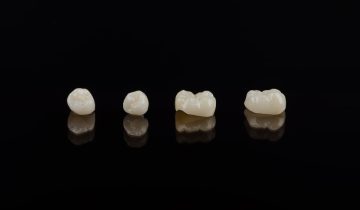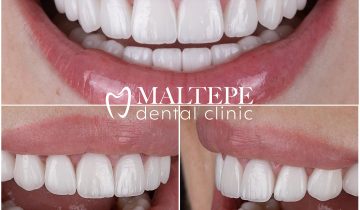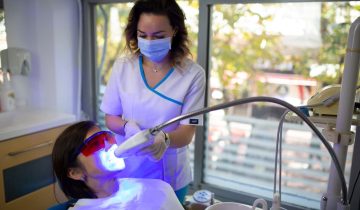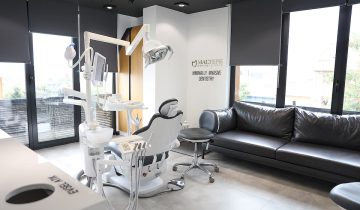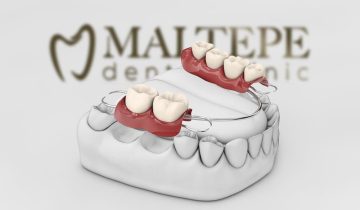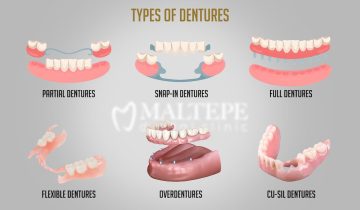Last updated on August 16th, 2023
Many patients who are having problems with decayed teeth, especially in the back of the mouth, think that dental crowns or fillings are their only options, or that they have to choose one of the more conventional treatments. They tend to opt for dental filling for minor cavities and dental crowns for more severe decay. What if the cavities are too large to cover with traditional fillings, and at the same time, too small for a dental crown? Then dental inlays and onlays (also known as partial crowns) may be the perfect solution for you.
Porcelain inlays and onlays can restore decayed teeth functionally and aesthetically. The procedure is simple, and the results are long-lasting. In this article, you will read about porcelain inlays and onlays, and their benefits. We will also provide you with some technical information about the procedure of getting porcelain inlays and onlays referring to scientific papers. In the last section of the article, we will address frequently asked questions about this type of dental restoration.
What Are Porcelain Inlays, Onlays and Crowns? And What Is The Difference?
A dental inlay can be defined as the pre-molded filling to fit the grooves of a decayed tooth. It is used to repair smaller areas of damage or decay that don’t extend to the tooth cusps or edges. The lost surface of the tooth is replaced with a porcelain cement prepared in a dental laboratory. Inlays are usually made of porcelain or composite materials and are custom-made to fit the exact shape and size of the cavity. Although inlays made of gold and other metals are common, porcelain inlays have been growing in popularity as they look more like natural teeth.
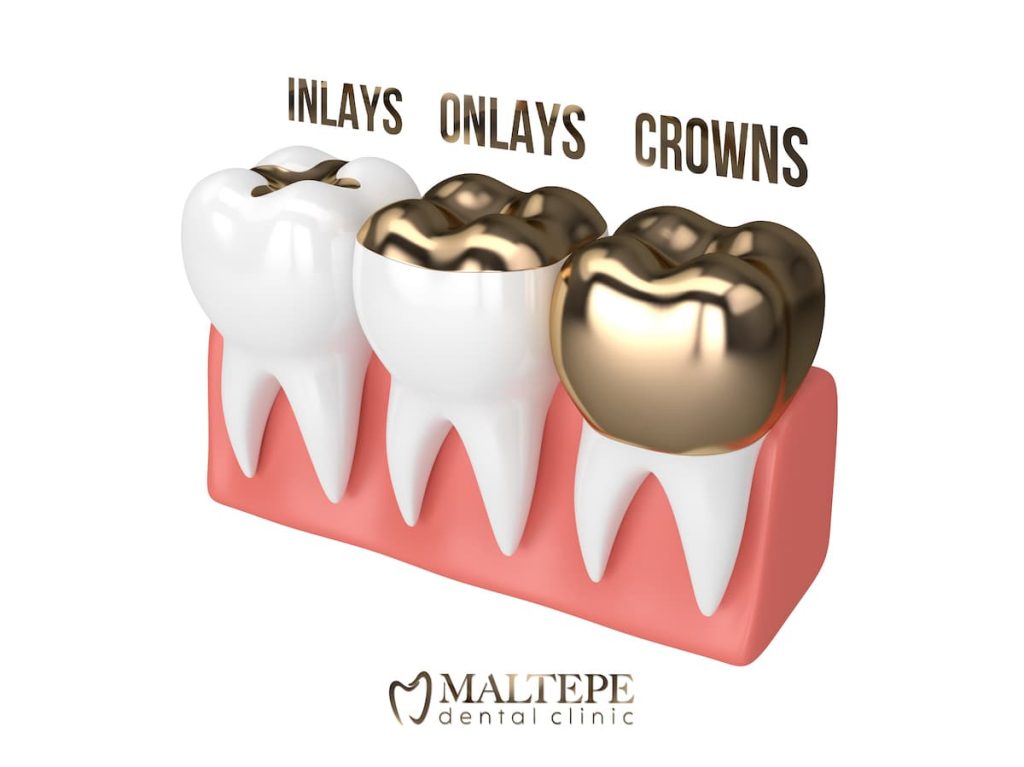
A dental onlay is similar to a dental inlay, with the only difference being the size and the area it covers. A porcelain dental onlay is custom-made in a dental laboratory just like an inlay. However, an onlay covers not only the grooves but also the entire tooth surface. Thus, it is most preferred when the damage or decay is on the cusps of the tooth, which provides the patient with a safer biting area.
A crown is a tooth-shaped cap that covers the entire tooth above the gum line. Crowns are used when a tooth is extensively damaged, decayed, or weakened by a large filling, and needs to be strengthened and protected.
Overall, inlays, onlays, and crowns are all effective ways to repair damaged teeth, but the choice of which one to use depends on the extent of the damage and the location of the affected tooth in the mouth. Your dentist can recommend the best option for your specific situation.
Advantages Of Using Porcelain Inlays And Onlays
Dental professionals tend to opt for porcelain inlays and onlays due to one or more of the following reasons:
– They require only a conservative amount of preparation, which allows the dentist to preserve a large amount of the healthy tooth structure.
– They stand out as a great alternative to full coverage crowns if the patient only has minimal to moderate tooth damage.
– In particular, porcelain inlays and onlays look like a natural part of your tooth, and they don’t discolor after time.
– The custom fit of porcelain inlays and onlays provides for more comfortable cleaning and easier maintenance.
– If the cavity is between two teeth, inlays can function as a proper seal to keep the bacteria out of the damaged area.
– Thanks to the strength of porcelain, inlays, and onlays offer a high level of functionality and durability. Therefore, porcelain inlays and onlays are practical and secure restoration solutions.
How Porcelain Inlays and Onlays Can Restore Your Smile?
Inlays and onlays are effective ways of restoring patients’ smiles. Although inlays and onlays are primarily considered a treatment option for decayed teeth in the back of the mouth, they can be a very handy solution for cracked or chipped front teeth, as well.
It is well known those beautiful front teeth give a person a beautiful smile and self-confidence. Minor or moderate degrees of cracks on the front teeth can be a real barrier to smiling confidently, especially when one or more of those teeth are chipped, too. Porcelain inlays and onlays work perfectly in this situation. They perfectly match patients’ natural teeth color, which allows dental professionals to preserve the existing tooth from further decay. Moreover, porcelain inlays and onlays are stain resistant, which means patients will not have to deal with stains or discoloration later on.
Even though there are inlays and onlays made of other materials, such as composite and gold, porcelain inlays and onlays provide patients with enhanced functionality and aesthetics, which translates into more beautiful smiles.
What Are The Survival Rates Of Inlays And Onlays Compared To Complete Coverage Restorations?
Patients ask a lot of questions about porcelain inlays and onlays, particularly about the survival rate of this dental procedure. According to a study published in The Journal of Oral Rehabilitation in 2018, inlays and onlays offer a very high survival rate. The survival rate for crowns and inlays/onlays after five years is exceptionally high, surpassing 90%. Here are the average survival rates for each treatment group in the study for comparison purposes:
Inlays: 90.89%
Onlays: 93.5%
Inlay + Onlay: 99.43%
Complete coverage restorations (crowns) 95.38%
As the figures suggest, inlays and onlays show great survival especially when they are applied together; even higher than crowns.
The Procedure For Getting Porcelain Inlays And Onlays
The procedure for inlays and onlays are performed at a dental clinic or a dentist’s office. Though there might be slight procedural differences based on the type of the material and the patient’s dental issues, usually the following steps are taken in porcelain inlays and onlays treatment:
- The patient sits in the dentist’s chair and a clear shield is put on to protect his/her eyes from sprays and other dental materials.
- The dentist numbs the area in the patient’s mouth.
- The dentist removes the damaged part of the tooth and cleans the area using dental disinfecting agents.
- The dentist takes an impression of the clean tooth.
- If it is a direct inlay/onlay treatment, the dentist can make a permanent inlay or onlay in the office right then and there, and place the porcelain cement on the decayed parts of the tooth.
- In some dental clinics, the cement is made in a dental laboratory instead of the dentist’s office, consequently this might take some additional time. Meanwhile, the dentist places a temporary inlay or onlay on the tooth.
- Once the permanent inlays/onlays are ready, the patient visits the dentist again, and the dentist replaces the temporary inlays/onlays with the permanent ones using a strong adhesive.
- Finally, the dentist gives the inlay/onlay a smoother shape and polishes the surface so that the patient can achieve a safe and comfortable bite.
How To Care Your Porcelain Inlays And Onlays
Once you have your inlays or onlays, your dentist might instruct you not to eat or drink until the numbness in your mouth wears off. This is a typical aftercare routine immediately after treatment.
In the long term, porcelain inlays and onlays can restore your natural healthy teeth and give you your beautiful smile back. However, keep in mind that your teeth are not entirely covered with porcelain. Therefore, you should still practice your regular tooth-brushing routine along with flossing. Keeping the teeth free from debris and acidic stains will ensure your oral health in the long term.
FAQs
Are Inlays And Onlays The Same As A Filling?
No, they aren’t. Inlays and onlays are single solid pieces fitting the cavity size, usually too large to fill with filling. A filling is a composite or amalgam material shaped onto the tooth.
How Long Does An Inlay And Onlay Last?
They last as long as crowns (10-15 years).
Is An Onlay Cheaper Than A Crown?
Yes, it is usually a more affordable option. Here you can read a blog about ‘Why are dental crowns so expensive?’.
Can An Onlay Fall Off?
It is very rare but possible due to improper adherence or over-brushing. Also, eating hard and sticky foods can cause an onlay to fall off.
How Long After Onlay Can I Eat?
Waiting at least a few hours is a good idea until the numbness goes away, and so that you get used to the newly shaped tooth in your mouth. However, you should still avoid having hot or cold foods and drinks for at least 24 hours.
Can I Chew Gum With An Onlay?
Yes. Once the anesthesia wears off, you can chew anything.
Can I Brush My Teeth After Inlay?
If you don’t feel any discomfort or sensitivity, you can perform routine tooth brushing after an inlay.
Is Getting A Tooth Onlay Painful?
No, it is not painful.

